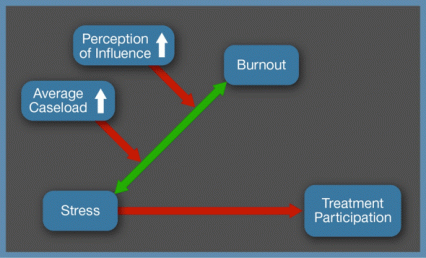Substance abuse treatment is stressful work. Treatment professionals must deal with problems that are complex and urgent, often with limited resources. A NIDA-supported study suggests that outpatient drug-free programs can help substance abuse treatment professionals reduce their stress and more effectively engage patients in treatment.
Dr. Brittany Landrum, Dr. Danica K. Knight, and Dr. Patrick M. Flynn of Texas Christian University in Fort Worth surveyed staff and patients in 89 outpatient drug-free programs in nine states. Staff who had direct contact with patients filled out the Survey of Organizational Functioning. Patients completed the Client Evaluation of Self and Treatment questionnaire.
The survey results revealed that when staff members reported lower levels of stress, patients reported more active participation in treatment (see figure). The results also suggested treatment programs can reduce staff stress by giving employees a voice in organizational policies and procedures. Staff who rated their influence within their programs as relatively high tolerated stress with fewer symptoms of burnout—emotional exhaustion and low sense of personal accomplishment—than staff who rated their influence as relatively low.
Surprisingly, the link between staff stress and burnout was weaker in programs with higher patient caseloads than those with lower caseloads. The researchers speculate that counselors who have more patients to treat can channel their stress positively into a sense of challenge that may be protective against burnout.
 Patients Report Higher Treatment Engagement in Programs Where Staff Report Less Stress In a study of outpatient drug-free treatment programs, staff reported less burnout in those programs where they had higher perceived influence in organizational decisions and where they had higher average caseloads.
Patients Report Higher Treatment Engagement in Programs Where Staff Report Less Stress In a study of outpatient drug-free treatment programs, staff reported less burnout in those programs where they had higher perceived influence in organizational decisions and where they had higher average caseloads.This study was supported by NIH grants DA014468, DA014468-01A2, DA014468-02, DA014468-02S1, DA014468-03, DA014468-04, and DA014468-05.
Source
Landrum, B.; Knight, D.K.; and Flynn, P.M. The impact of organizational stress and burnout on client engagement. Journal of Substance Abuse Treatment 42(2):222–230, 2012. Abstract
